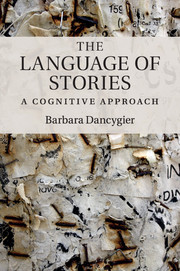Book contents
- Frontmatter
- Contents
- Figures
- Acknowledgements
- Introduction
- 1 Language and literary narratives
- 2 Blending, narrative spaces, and the emergent story
- 3 Stories and their tellers
- 4 Viewpoint
- 5 Referential expressions and narrative spaces
- 6 Fictional minds and embodiment in drama and fiction
- 7 Speech and thought in the narrative
- 8 Stories in the mind
- Notes to the text
- References
- Literary works cited
- Index
5 - Referential expressions and narrative spaces
Published online by Cambridge University Press: 05 November 2011
- Frontmatter
- Contents
- Figures
- Acknowledgements
- Introduction
- 1 Language and literary narratives
- 2 Blending, narrative spaces, and the emergent story
- 3 Stories and their tellers
- 4 Viewpoint
- 5 Referential expressions and narrative spaces
- 6 Fictional minds and embodiment in drama and fiction
- 7 Speech and thought in the narrative
- 8 Stories in the mind
- Notes to the text
- References
- Literary works cited
- Index
Summary
Do you want to grow up to be Miss New Jersey just like your mommy?
(American Pastoral, Philip Roth)This chapter presents an overview of selected patterns in which referential expressions are used in the narrative. The analyses presented here cannot exhaust the issues, but they are intended to show that the mental space complexity of narratives creates a number of cross-space links which can then be manipulated or differently construed through the use of any referential form – a pronoun, a name, or a role-descriptor. Reference in narratives is thus a matter of emerging complex referential networks.
There are many specific problems in this area of language use. First of all, pronouns in the narrative need a specific treatment with respect to the different nature of deixis in fictional texts. In , I have signaled some characteristics of the first-person versus third-person choices which structure novels in their entirety, and in I will return to the issue of the narrative use of pronouns in speech and thought representation blends. In this chapter, I will consider two other classes of referential expressions: proper names and role-descriptors. will also propose a brief discussion of how the use of common nouns in constructions such as ‘fictive motion’ (Talmy ; Matlock ) can profile participants in the narrative space. The chapter ends with an excursion into contemporary poetry, to add to the understanding of deictic pronouns in literary contexts.
- Type
- Chapter
- Information
- The Language of StoriesA Cognitive Approach, pp. 117 - 138Publisher: Cambridge University PressPrint publication year: 2011

